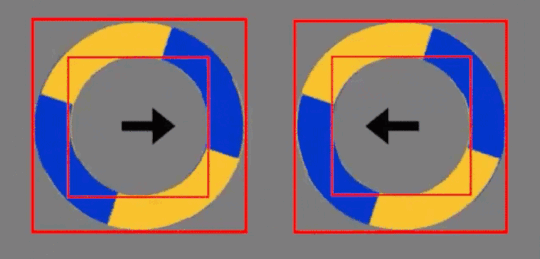Week 1, Day 3: Seeing context
This isn’t an Advent scripture, but it’s good quote to introduce today’s optical illusion:
“When they moved, the wheels moved; when they stood still, the wheels stood still; and when they rose above the earth, the wheels rose up along with them, because the spirit of the creatures was in the wheels.” (Ezekiel 1:21)
In this optical illusion, the motion of the wheels is the same, but you will observe them moving left right, up, down, and in and out.

At first, I thought the arrows had something to do with the illusion of motion, but it turns out that the main effect is caused by a faint border of pixels around the wheels. If you cover up the arrows, the wheels still seem to move in different directions. (An explanation for how the optical illusion works can be found here.) Some people report that the arrows give the illusion a “boost,” making the motion more prominent.
In the last two devotionals, I pointed out that a) we don’t see things that are there, and b) we do see things that aren’t there. This illusion demonstrates that our brains interpret ambiguous data from very subtle context clues.
As a pastor and counselor, I try to be very sensitive to context. Context determines how we understand the narrative trajectory of the Bible. For example, do we read the New Testament as a story of a wrathful God throwing us one last lifeline before damning all of creation to hell and destruction? Or do we read it as an unfolding revelation of God’s grace, with Jesus as a herald of a new kingdom? You can certainly find support for either reading. I believe context imparts a certain direction to our reading.
I read the Bible as the story of God’s faithfulness to God’s people, a God who has been trying for ages to teach the principles of abundance (manna) and forgiveness (mercy) to humans who are infatuated with an economics of scarcity and a politics of coercive power. I come to this reading because of my own social context (how I was raised, the groups I identify with, etc.) and because of the historical context of the Bible. The Bible was written by escaped slaves, returning exiles, and oppressed people. Even though I belong to none of those groups, I see the direction of scripture informed by that background.
And I see it especially in the story of the pregnancy of an unwed mother, the visit of pagan astrologers, and their family’s refugee flight to Egypt. When I read scripture, I try to imagine what seeing it in or from a different context would be like. I squint, I cover up arrows, I draw lines around it. I apply historical, literary, intertextual, and womanist and queer lenses to see what the movement of scripture looks like from a different perspective. All of this makes me more aware of how my own consciousness, my own experience, shapes how I understand the movement of God not only in scripture, but in the world.
Prayer: God, help us to pay attention to context. Help us see through eyes other than our own. Amen.
—Rev. Dr. David Barnhart, Jr.
(Optical illusion based on the work of Twitter user @jagarikin. )
(You can support the ministry of Saint Junia United Methodist Church by clicking here.)



